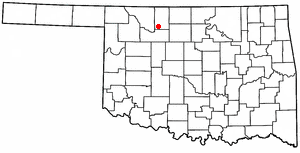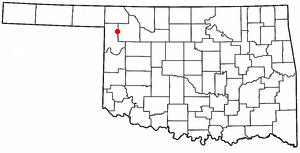
Garfield County is a county located in the U.S. state of Oklahoma. As of the 2020 census, the population was 62,846. Enid is the county seat and largest city within Garfield County. The county is named after President James A. Garfield.

Alfalfa County is a county located in the U.S. state of Oklahoma. As of the 2020 census, the population was 5,699. The county seat is Cherokee.

Aline is a town in Alfalfa County, Oklahoma, United States. The population was 168 at the time of the 2020 Census.

Burlington is a town in northwestern Alfalfa County, Oklahoma, United States. The population was 152 at the 2010 census.

Byron is a town in Alfalfa County, Oklahoma, United States. The population was 35 at the time of the 2010 census.

Cherokee is the largest city within, and county seat of, Alfalfa County, Oklahoma, United States. The population was 1,476 at the 2020 census, a decline of 1.5 percent from 2010.

Goltry is an incorporated rural small town in Alfalfa County, Oklahoma, United States. The population was 249 at the 2010 census. Located there are a town hall, a post office, a farmer's co-op with gas service, a fire department, and a bank, with several blocks of homes.

Helena is a town in southeastern Alfalfa County, Oklahoma, United States. Residents pronounce the town's name with a long E: "Heh-LEE'-nuh." The population was 1,403 at the 2010 census.

Jet is a town in southeast Alfalfa County, Oklahoma, United States. The population was 197 at the time of the 2020 Census.

Lambert is a town in Alfalfa County, Oklahoma, United States. The population was 5 at the time of the 2020 Census.

Fargo is a town in Ellis County, Oklahoma, United States. The population was 312 at the time of the 2020 census. Fargo, like many towns in the region, has never fully recovered from the Dust Bowl years.

Shattuck is a town in Ellis County, Oklahoma, United States. The population was 1,249 at the time of the 2020 census, a change from the 1,356 reported in the 2010 census.

Breckinridge, sometimes spelled Breckenridge, is a town in Garfield County, Oklahoma, United States. The population was 199 as of the 2020 Census.

Covington is a town in Garfield County, Oklahoma, United States. The population was 477 at the 2020 census.

Drummond is a town in Garfield County, Oklahoma, United States. The population was 455 at the 2010 census, up from 405 in 2000.

Fairmont is a town in Garfield County, Oklahoma, United States. The population was 134 at the 2010 census, a decrease from 147 at the 2000 census.

Hunter is a town in Garfield County, Oklahoma, United States. The population was 165 at the 2010 census, a 4.6 percent decline from the figure of 173 in 2000.

Lahoma is a town in Garfield County, Oklahoma, United States. The population was 611 at the 2010 census, a 5.9 percent gain over the figure of 577 in 2000. Its name was formed from the last three syllables of Oklahoma. Until the 1960s, Lahoma was a farm town. Later, it became primarily a bedroom community for people who commuted to work in Enid.
Ingersoll is a small unincorporated community in Alfalfa County, Oklahoma, United States.
Driftwood is a small unincorporated community in northern Alfalfa County, Oklahoma, United States. A formerly prosperous small rural community, at one time it had two churches, a grocery store, barber shop, gas station with repair shop, grain elevator, two-story school, a telephone office, bank, and post office. Currently, it is made up of less than a dozen residences - along with a church and cemetery - grouped along both sides of Oklahoma State Highway 8/State Highway 58.










